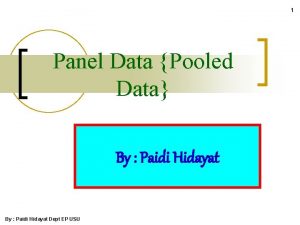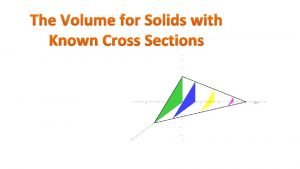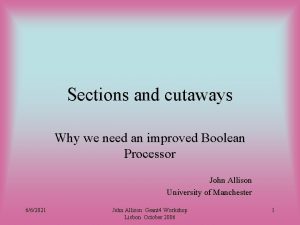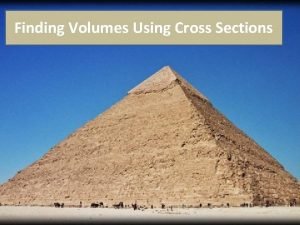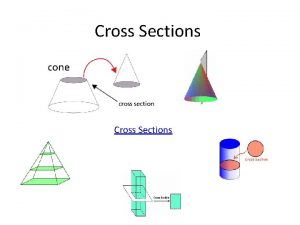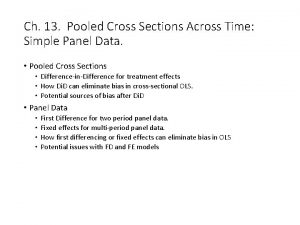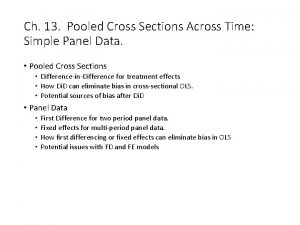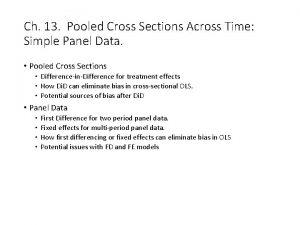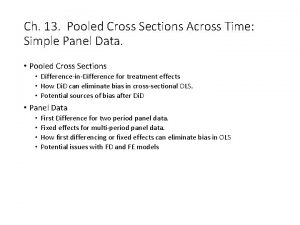Pooling Cross Sections across Time Simple Panel Data








- Slides: 8

Pooling Cross Sections across Time: Simple Panel Data Methods Chapter 13 Wooldridge: Introductory Econometrics: A Modern Approach, 5 e © 2013 Cengage Learning. All Rights Reserved. May not be scanned, copied or duplicated, or posted to a publicly accessible website, in whole or in part.

Pooled Cross Sections and Simple Panel Data Methods Policy analysis with pooled cross sections Two or more independently sampled cross sections can be used to evaluate the impact of a certain event or policy change Example: Effect of new garbage incinerator on housing prices Examine the effect of the location of a house on its price before and after the garbage incinerator was built: After incinerator was built Before incinerator was built © 2013 Cengage Learning. All Rights Reserved. May not be scanned, copied or duplicated, or posted to a publicly accessible website, in whole or in part.

Pooled Cross Sections and Simple Panel Data Methods Example: Garbage incinerator and housing prices (cont. ) It would be wrong to conclude from the regression after the incinerator is there that being near the incinerator depresses prices so strongly One has to compare with the situation before the incinerator was built: In the given case, this is equivalent to Incinerator depresses prices but location was one with lower prices anyway This is the so called difference-in-differences estimator (Di. D) © 2013 Cengage Learning. All Rights Reserved. May not be scanned, copied or duplicated, or posted to a publicly accessible website, in whole or in part.

Pooled Cross Sections and Simple Panel Data Methods Difference-in-differences in a regression framework Differential effect of being in the location and after the incinerator was built In this way standard errors for the Di. D-effect can be obtained If houses sold before and after the incinerator was built were systematically different, further explanatory variables should be included This will also reduce the error variance and thus standard errors Before/After comparisons in "natural experiments" Di. D can be used to evaluate policy changes or other exogenous events © 2013 Cengage Learning. All Rights Reserved. May not be scanned, copied or duplicated, or posted to a publicly accessible website, in whole or in part.

Pooled Cross Sections and Simple Panel Data Methods Policy evaluation using difference-in-differences Compare outcomes of the two groups before and after the policy change Compare the difference in outcomes of the units that are affected by the policy change (= treatment group) and those who are not affected (= control group) before and after the policy was enacted. For example, the level of unemployment benefits is cut but only for group A (= treatment group). Group A normally has longer unemployment durations than group B (= control group). If the difference in unemployment durations between group A and group B becomes smaller after the reform, reducing unemployment benefits reduces unemployment duration for those affected. Caution: Difference-in-differences only works if the difference in outcomes between the two groups is not changed by other factors than the policy change (e. g. there must be no differential trends). © 2013 Cengage Learning. All Rights Reserved. May not be scanned, copied or duplicated, or posted to a publicly accessible website, in whole or in part.

Pooled Cross Sections and Simple Panel Data Methods Two-period panel data analysis Example: Effect of unemployment on city crime rate Assume that no other explanatory variables are available. Will it be possible to estimate the causal effect of unemployment on crime? Yes, if cities are observed for at least two periods and other factors affecting crime stay approximately constant over those periods: Time dummy for the second period Unobserved time-constant factors (= fixed effect) Other unobserved factors (= idiosyncratic error) © 2013 Cengage Learning. All Rights Reserved. May not be scanned, copied or duplicated, or posted to a publicly accessible website, in whole or in part.

Pooled Cross Sections and Simple Panel Data Methods Example: Effect of unemployment on city crime rate (cont. ) Subtract: Estimate differenced equation by OLS: Fixed effect drops out! + 1 percentage point unemployment rate leads to 2. 22 more crimes per 1, 000 people Secular increase in crime © 2013 Cengage Learning. All Rights Reserved. May not be scanned, copied or duplicated, or posted to a publicly accessible website, in whole or in part.

Pooled Cross Sections and Simple Panel Data Methods Discussion of first-differenced panel estimator Further explanatory variables may be included in original equation Note that there may be arbitrary correlation between the unobserved time-invariant characteristics and the included explanatory variables OLS in the original equation would therefore be inconsistent The first-differenced panel estimator is thus a way to consistently estimate causal effects in the presence of time-invariant endogeneity For consistency, strict exogeneity has to hold in the original equation First-differenced estimates will be imprecise if explanatory variables vary only little over time (no estimate possible if time-invariant) © 2013 Cengage Learning. All Rights Reserved. May not be scanned, copied or duplicated, or posted to a publicly accessible website, in whole or in part.


